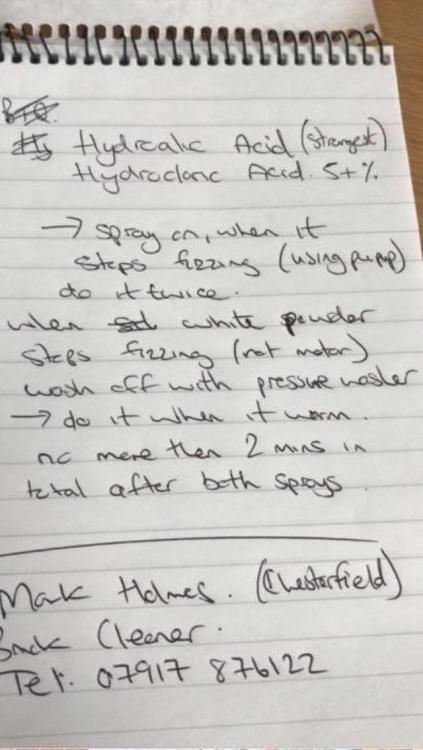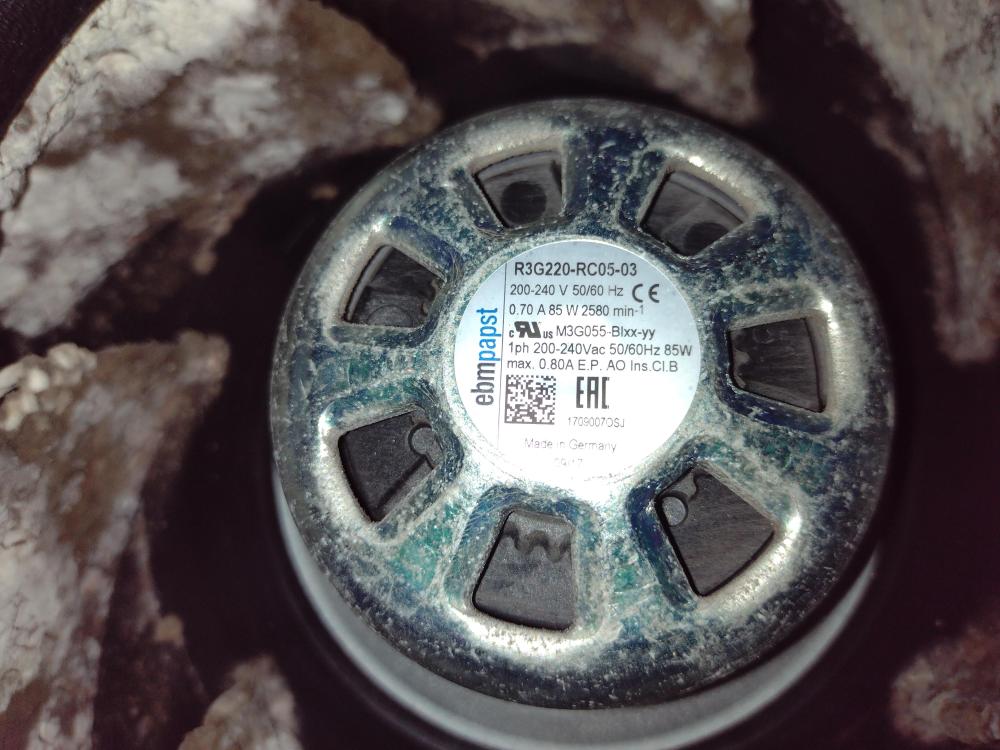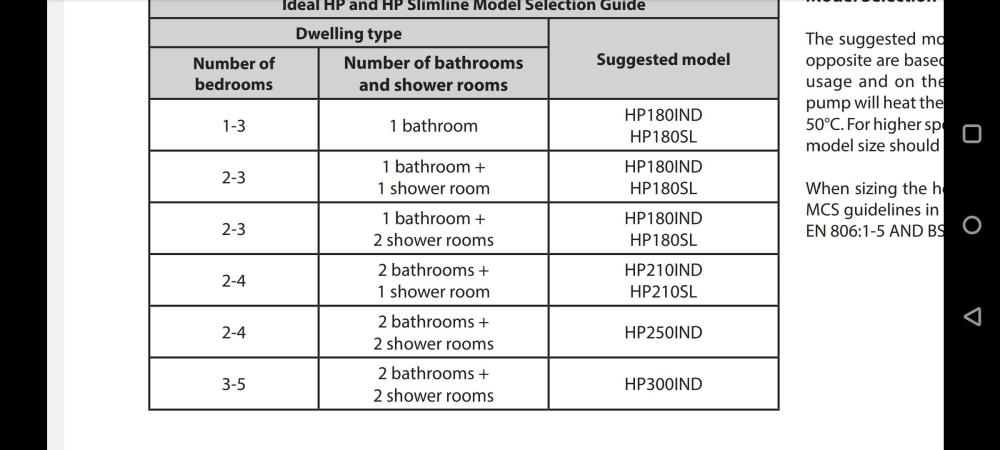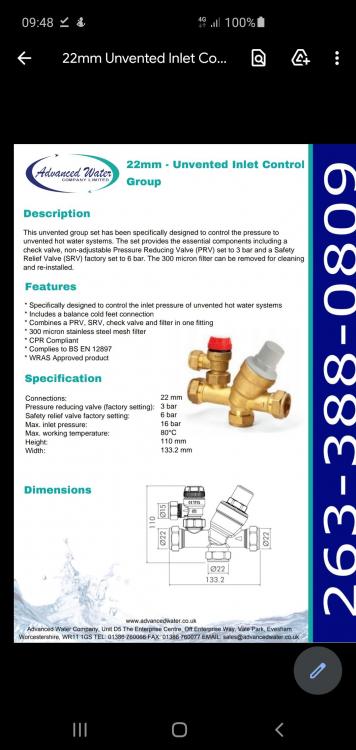Leaderboard
Popular Content
Showing content with the highest reputation on 03/10/24 in all areas
-
Should be 2 layers of 15mm pink fireline board with staggered joints. Mounted on resiliant bars for reduced noise. Was there any insulation in there that came down with the ceiling that might not have been replaced?3 points
-
About a quarter of me has some sympathy for the domestic heating industry. For decades they have been able to get away with just shoving in a 28kW boiler to serve a typical 8kW load, leave it set to the defaults, put trvs on unbalanced oversized radiators, and it all works as far as the customer is concerned. Granted it doesn't condense as it should, and the thermal gradients (in both time and space) are higher than they need to be, so its both less efficient and less comfortable than it could be, but energy was cheap and the customer is used to thermal gradients so doesn't care as long as they are warm. Better still they can sell lots of 'intelligent' upgrades which purport to save money but probably save much less than would be saved by setting the system up optimally. Then two things happen. Energy prices rocket and there is a push to switch to a new technology which means you actually need to think about the sizing, radiator balancing and sundry other variables, and worst of all the customer now cares about and is conscious of the efficiency. Its a massive shift, perhaps it's not entirely surprising that the industry has struggled. OK that's the quarter of me that has sympathy. The remaining three quarters says that the industry should, by now, have recognised this and managed the situation properly and more fairly and openly to the customer. On fairness many appear to have done so, but it also appears that others have not.3 points
-
There will be in flats, also a requirement as part of the lease hold agreement.2 points
-
As I say three quarters of me agrees. However it helps to understand another perspective. We have a deep seated cultural problem in the UK (I'm not sure it's unique to the UK) that plumbing, electrics and most other engineering skills with a practical side are perceived as inferior to desk based roles in finance, and pay and/or are perceived to pay less. So, unsurprisingly, many of our more capable people, who would relish the change as an opportunity to develop new skills, choose to avoid them.2 points
-
@Thorfun, that's because their warm slab is an on-ground insulation-wrapped slab. A warm basement is a completely different design requirement.1 point
-
With anything like the 25mm you propose it will be a cold miserable place. 50mm min in walls, 50 in the floor and 150loft roll it will still be under spec but will make it useable without having to spend a fortune on heating. it does depend on what you want it for and how big it is. I have a lovely cosy garden room, but it’s only 9m square so a small area to heat.1 point
-
Can't comment on inhibitor but pleased to hear pipes have been solved. Average house has dozens and dozens and dozens of pipe joints without issue, put this behind you now and crack on!1 point
-
There's certainly a lot of debate about it. Here is a video that I think takes a reasonable approach to it:1 point
-
The most convincing argument for a buffer tank is if your warranty requires you to have one. My warranty obliges me to have a buffer tank. As someone who had his entire heat pump replaced under warranty after 3 years of service, I would caution against doing something that might void the warranty.1 point
-
I use the McApline on every install, and all projects are airtight etc. These just go to the soil stack wherever that connection is practically made. The G3 regs state the maximum length of the D2, including reductions for 90° bends etc, so you may have to beef that up to 28mm1 point
-
It also says “wherever possible”. There are ways to build close to the boundary without foundations, soffits or gutters overhanging. So if that can be proved to the LPA (where there are situations with less than 300mm), then that should be acceptable.1 point
-
By way of 2016-17 prices, our village plot was worth about £150-200K, bought-ins about £350K, labour and profession fees save by our contribution maybe another £120K giving an effective total of £650K which was about what roughly comparable houses were selling for in a village setting at the time. OK, splitting the plot off probably lost us only about £50K off the selling price of our old farmhouse. We have no CiL then and saved on stamp duties so probably saved ourselves maybe £250K on buying a "comparable" previously built house in the area. Except of course that you could buy a passive-class house and certainly not the exact spec that we wanted nor to the build standard that we actually achieved. There were some major cost elements imposed by the LPA, e.g. local stone exterior skin, and natural slate roof, that added to our bought-ins. At today's prices we would probably be looking at £750-800K to do a custom build to this spec. Can I suggest that it might be worth looking at an MBC twinwall TF build as an alternative to ICF at least for the main living space? Their warm slab and TF design patterns have been well tuned to a passive-class standard over more than a decade's refinement. I agree that if you've run your own building company, then you and whoever else in your family that worked in it will have lots of relevant experience, and you will have many areas of expertise in-house that you can either use directly or to enable a decent level of quality control. One thing that many here evangelise is achieving a passive class build as this has major running cost savings, as well a far more comfortable living environment. We are in our early 70s now, so we appreciate this as we age. We keep our entire house at 21-23 °C (the first floor bedrooms are a couple of degrees cooler than the ground floor) 24 × 7, and really miss this when we visit our children and other relatives. I personally would recommend that you or one of your close family really gets their head around the implications of building to passive class: where the heat goes and (through solar gain) where it comes in. Relevant contributions of: slab losses, external walls, roof, fenestration, air exchanges. Get a good feel for the impact of U values and how these reflect unit costs and performance; air-tightness and air exchange losses, and so on. You will need to make various trade-offs to optimise costs vs achievement off your overall spec, and you or someone you really trust has to make these decisions. Achieving this class of house requires an attention to detail both in design and in construction. It is not unusual for two houses with the same nominal as-designed spec to vary in as-built performance by a factor of 2. An example "close to home" is that my daughter's living room is impossible to heat economically: the large panel of bifold doors leading onto the garden have a poor U-value and leak terribly; areas of wall and ceiling insulation are missing. You haven't mentioned your age, but I infer that you are getting close to retirement and therefore this will be your property "to retire into", so living comfort will be important. You've mentioned a gym and workshop but what you have mentioned in bridging space to the exterior: a conservation or atrium. I am not talking about the 5 × 4m bolt on the side of an existing property, but in your case you have lots of area to include a decent spacious environment that to could properly integrate into the building fabric, and that could connect you to the garden. OK, not needed in the summer where you are planning to build, but this could extend you comfortable "outside-ish" space for another 3-4 months of the year. BTW, even Nick (@SteamyTea) would admit to being a tad irascible at times; yes, he is also very particular about units, dimensions etc., because the implications of kW vs kWh, etc. are a lot more than a little "h". He is also well respected for his contributions here by the forum regulars. 🙂1 point
-
I used them. Given space isn't quite so tight above presence sensors no real need to use the gel crimps, you can if you prefer though.1 point
-
The 1m gap is down to your LPA’s policies. Policies only kick in for non-PD works. The PWA doesn’t have anything to do with Planning. If you’re excavating within 3m of a neighbouring building and the foundations will be deeper than those to your neighbours, you will be required to serve a Party Wall Notice. It doesn’t matter where the extension is located. Those that require Planning are checked against policies. Those that do not comply will be refused.1 point
-
Ps. We paid for 13.5mm and I also don’t know if 12mm is up to building regs. Will be questioning them tomorrow.1 point
-
Yeah the landing. We decided to cut out the floating flooring in the end and fixed straight down to the structure. It is solid!! will speak to the manufacturer tomorrow but as it’s Sunday I figured I’d ask on here in case any of the awesome members knew.1 point
-
Some types of timber cladding can be really poor, there is a self build with timber cladding near me that in the winter the cladding just soaks in the rainwater, and ends up looking like a cheap soaked garden shed. I have never been a fan of cladding "left to silver" as it rarely fades evenly and often looks tatty and worn after a very short time.1 point
-
Timber framed timber clad not lasting is down to how they are built and detailed and not the build method. It’s the predominant build method in Scandic countries after all. The weather patterns are slightly different and the west coast of Scotland is one of the wettest in Europe. Nevertheless built properly there’s no reason why they shouldn’t last. That said, having experienced Skye builders I can see why they aren’t built well.1 point
-
Honestly that sealer above will really bring it to life. There's an Evanescence joke there somewhere...1 point
-
I would alter the slates/tiles and do the flat roof and cheeks externally, so that the insulation is outboard of the structural frame.1 point
-
1 point
-
The cold inlet is at the bottom, and water will take the path of least resistance to exit the cylinder, ergo the hot water at the top will make its way out. Me, personally, I don't like the "bubble-top" arrangements, as these need to be drained down periodically to regenerate the "bubble", and I would have an expansion vessel without a moments thought. Then you are at true '100%' useful capacity vs space / size.1 point
-
Not in my experience. Nothing like that high. Perhaps that’s under certain circumstances. Like when they are run continuously at full rated current or something. Failed inside what timeframe? I fit hundreds of RCBO’s every year. Probably not far off 1000. I probably get 1 or 2 failures a year, even including devices fitted years previously. Admittedly though most people don’t use the test button! So if you’re including failure to operate under fault conditions then the figure will be higher. I assume you guys are thinking of total failure ie no power to circuit. As above it’s different if they are subjected to substantial current flow. The reality is that the vast majority are only having to deal with 1 or 2 amps at the most either all the time or nearly all the time. Electric showers and EV chargers are the biggest culprits for causing RCBO failure.1 point
-
The only disappointment with my build was noise between floors with a single skin of board and sound insulation, wish I had resilient bars. But surely there are noise regs regarding flats 🤷♂️1 point
-
The dangers of asbestos have been known for a long time. The first medical paper was published in 1924 in the BMJ and there were suspicions well before then. That paper dealt with fibrosis of the lung and TB. Suspicions of a link to cancer started in the 1930s and were confirmed in 1955 by Richard Doll. https://www.ncbi.nlm.nih.gov/pmc/articles/PMC1742940/ My father had H&S responsibilities in an aluminium recycling company and he had to consider the danger of asbestos in the early70s. If we had a no fault compensation system then suing wouldn't be necessary, unfortunately we don't, so that's the course you may have to take in order to get compensation for something caused by others inaction. I agree that the dangers of asbestos to the general public are overblown, like many other issues.1 point
-
1 point
-
Hire a Spit nail gun. Will make clipping / mechanical fixings a doddle. No more drill / plug / screw etc.1 point
-
1 point
-
That's a comment in two halves. Tha first I agree with, absolutely plumbing and electrics done properly are much, much more than a minimum wage skill. The second half not so sure. All to often I find myself doing DIY plumbing (in particular) or electrics (less so) because I'm fed up with having inane arguments, that have no basis in engineering or physics, with people who obviously haven't got a scooby and/or don't want to quote for the job that needs doing. However I grant it's chicken and egg. The cultural problem I refer to above is a severe disincentive for the most highly skilled people to get involved in either trade (and indeed many others).1 point
-
I have extracted failing fan, very very dirty rotor covered in dust n fungus so that will need a good clean, hopefully not disturbing any balance weights. Wonder if growth built up in balance? Fan motor number there, I'm timed out for tonight so will have to pick up next opportunity. There are YouTube vids for similar fans if you use search on bearing replace ebm papst fans, not sure which one will be closest to the hrx2 one yet. No connectors, wire ends straight to screw terminals in control panel. Motor I have to replace bearings in was already a replacement as I had a dud fan bearing in new unit, pretty annoyed as had to strip unit down to get into loft, rebuild and then find duff bearing, refused to send whole unit back as they wanted, so got away with getting just the replacement fan.1 point
-
I don't remember the precise predictions, but 1:100 storms have become something like 1:30 storms. Most of Cornwall is going to cope reasonably well with storms, there will always be the odd ones like Boscastle 2004, but that really was a quirk of topology. Storm surges are probably the biggest threat down here, but they tend to take out carparks and amusement arcades. The Wherrytown storm of 1962 is an interesting example, the sea defence has lasted well. New types of material are currently being tested there at the moment.1 point
-
Yes the only difference is the coil size, it's way bigger, so you excellent heat transfer. You could flow at low temps heat to 48-50, get very little heat loss at the same time. If you are future proofing make sure you size for a typical heat pump i.e. how many litres it holds, will be bigger than a normal gas boiler cylinder.1 point
-
1 point
-
I'm very pleased for you (and your son!) that it has all worked out so nicely. Well done for all the hard work. Great to hear how quality craftsmanship / materials really do allow the creation of low maintenance buildings. That you managed to do it on a tight budget doing a lot of work yourselves is even more impressive. That's a good rule. I'd also add don't pay anyone to do something you enjoy doing or enjoy learning to do. Hard work does take a while to recover from but it is ever so satisfying, I bet you all enjoyed working together to create something so nice. We are reasonably young compared to most self builders so stiff upper lip time I suppose. From the sounds of your post you feel like you made the right decision. Minus garages / workshop / gym and spaces that really don't need standard finishes we have about 600m2. We don't need all this space yet but we will grow into it as we need it. I only get a VAT refund and CIL self build discount once. Demobilising / remobilising, inflation and economies of scale have a hand in my decision. As does the current geopolitical state of the world. Our globalised supply chains are fully functional right now. They weren't a few years back, will they be in a few years time? I'm striking whilst the iron is hot. I hear you and I appreciate you taking the time out your day to warn me against doing anything silly. I would however suggest that a 1,200 m2 build (particularly with the large ancillary spaces we have) is not 5x the effort of a 230m2 space. We specifically designed our build to be geometrically simple and to avoid architectural fussiness. It is a great big rectangle which makes it simple to build. We also have perfect 360 degree access and plenty of room on site to store materials / equipment etc. This will make life easier. I have a turnkey price here from a very fancy (I swear half their budget goes on brochures) construction management company. They reckon they can do it just shy of £3 million fully fitted out furniture and everything. I reckon they have a huge (40%) profit margin on that and that we can do it for £1.8 million fully fitted out. Of course however we don't need it fitted out to the standard they are suggesting nor do we need all the space yet. I value simplicity and size over fussiness. The goal I've set (which I accept may be impossible) is to get the frame water tight / done inside of £1 million and get the majority of the first fix / some second fix done inside of 1.5 million. There is little point setting a target unless it is difficult to reach. I have every faith in our team, our family and myself. It helps that we ran a building company for years. We are not inexperienced and we have taken our time to use our knowledge to find the right people to work with. We also have the majority of the tools we need and knowledge of how to use them safely and efficiently. I look forward to hearing these thanks for taking the time to write all this up. Have a great weekend. Cheers, NB1 point
-
I've just rewatched it and it definitely says 3 and 4...but then on the video shows your setup! I take your advice. Cheers1 point
-
1 point
-
Not getting into an argument but the Nudura alignment system and access platform is designed to go on one and four so that you can board(3 board configuration)into the corners with both directions fully supported. Obviously, if you didn't use the platform, it's a moot point but not sure why anyone would advise differently. I know what it says in the manual and got over 100 pours under the belt. Only trying to help for your next pour.1 point
-
Works no problem, I even have 300mm pipe spacing, 100mm concrete and again no issue. But they are a bit of a learning curve. Few things I found through experimenting, you need to be aware of. Changing floor temperature and house is quite a long process (many hours), so a normal thermostat is just rubbish and you get big under and over swings. You really need to use a 0.1 Deg hysterisis thermostat. You cannot use room compensation as the algorithms cannot cope with the long reaction times. Don't bother trying to do temperature setbacks, they generally don't work the way you expect. You cannot switch the heating on at work and hope to have a warm house when you get home (unless you do when you arrive at work). There is zero point zoning, run as a single zone. Two options of how to operate, charge the floor and use like a storage heater, or continuously feed the floor at a low temperature. I have done both and they work equally well. 5 degs difference in flow temp is the difference in the two methods. I am on E7 with ASHP, battery and charge the floor at 33 degs (overnight), for between 7 and 12 hrs depending on outside temp, automated with a timer thermostat. Generally it takes another 12 to 18 hrs to cool enough for the heating to come back on again. The wife was quite shocked the other week when it was near freezing outside (6pm) and I told the heating actually went off at about 10am and was not coming back on until after midnight. You can't do that with 50mm screed.1 point
-
i had mine basically outside for 3 months. When i had the external wall taken out we were still actually using the kitchen (in a much reduced capacity) so i had the fridge freezer, washing machine and dishwasher out there. All worked great although in December I had to bring the fridge freezer into the adjoining room as it was too cold to actually operate. Builders weren't nice enough to board me in and going for milk in the morning was horrible, but all the gear survived just fine so id imagine a conservatory a significant thermal upgrade on this.1 point
-
You could but you would soon either have it overwritten or asked to provide your evidence / citations/ references. I dimly recall it was compared with encyclopedia brittanica and its veracity score was similar.1 point
-
But the principles apply. Play with them. Avoid their gimmicks for the last 1/2% improvement, and other fads. A lot of people on here have aimed for 'close to passivhaus' standard, in their own terms. In my opinion. Low and slow ashp, with the units positioned for aesthetics. No windmills. Consider future solar panels, by putting a cable duct in. But mostly, quality design detailing and construction, which trump everything else and are hard to achieve, so read other people's issues on BH for what to look for.1 point
-
Stick a fan heater out there to keep it just above freezing?1 point
-
For the purposes of thread closure, I have managed to find a sufficient stock of obsolete parts to keep things going for a bit longer for not much cash outlay. In the end it was a degraded sensor wire shorting on to the case causing the PCB problem (they have been replaced and tied up properly), a sick pump start capacitor and a sticky part in the 3 way valve. All of them displaying intermittent symptoms. Cash flow preserved for the moment... Only a small gas fitter bill. I can now get back to all the other broken things I need to fix and think about a plan for insulation improvements and a heatpump should we decide to keep this house.1 point
-
Us lot on BH have the advantages of 1. having many and various skills and experience. 2. can take an overview, unclouded by insular expertise. 3. can dare to be wrong. 4. Can think and state ...'but surely'...and wait to be corrected. 5. are very often collectively right. When my (and other) advice is not heeded I usually drop out of conversations. Maybe I'm wrong or maybe there's no point in further discussion. I've said nothing on this though so will read along. But I agree that being in the sun won't make much difference to an ashp, but being next to a big masonry wall in the sun might be a fair bit better than in a permanently dark and damp alley.1 point
-
and there is also a habit of humans not admitting they're wrong especially when there's been a large financial outlay or it might lose them face. so just because someone says "it's brilliant and works exactly as i hoped" or "i'm really happy with my purchase and wouldn't have done anything else" doesn't necessarily mean they're telling the truth as they don't want to look bad or admit they made a mistake. it takes a brave person to admit they were wrong1 point
-
i understand this but one thing i've learnt (and there have been many!) during my journey is that not all 'accredited' professionals are created equal. nothing beats getting the opinions of others (even if they are complete strangers on the internet) as they generally do not have any sort of vested interest in the questions you're asking or solutions you're trying to find. and then you can compare the answers and make an informed decision. Also there are many ways to skin a cat. and just because someone says one way is best doesn't mean there isn't another way that is equally as good. just my 2 cents.1 point
-
The wonderful thing about living in the free world is that it's your money, you earned it, spend it as you please! A fact sadly not celebrated as much in the old world as by our new world cousins. Some plans might help the collective masses gather our brains around the plan. I wish I'd put mine up, lots of good advice I might have received might have saved me lots of hassle!1 point
-
I have a SIP built Home Office in the very windy Northumberland, which is built in my back garden on screw piles (12 of them x 1.75 meters long). They were installed in less than a day, before the Home Office was built. It's not moved, or blown away including during Storm Arwin a couple of years ago which caused a lot of damage throughout the region.1 point
-
Thanks for the steer, you've got me looking at 'control groups' now. So aiui some of the components I have drawn individually are actually all part of one part. I will redo my drawing to show this. What manufacturer/supplier would you recommend for parts to go with the UVC like the control group. A quick Google shows im looking for something like this?:1 point
-
Don’t need the first PRV and strainer - balanced cold comes off the control group that you get with the UVC. best place for UVC cold feed drain is as it goes into the tank. Hot return goes into the tank at the top, not in to the cold feed. I feed WCs off the same branch as the outside taps but that is preference - they don’t need to have soft water or be reduced pressure.1 point

















